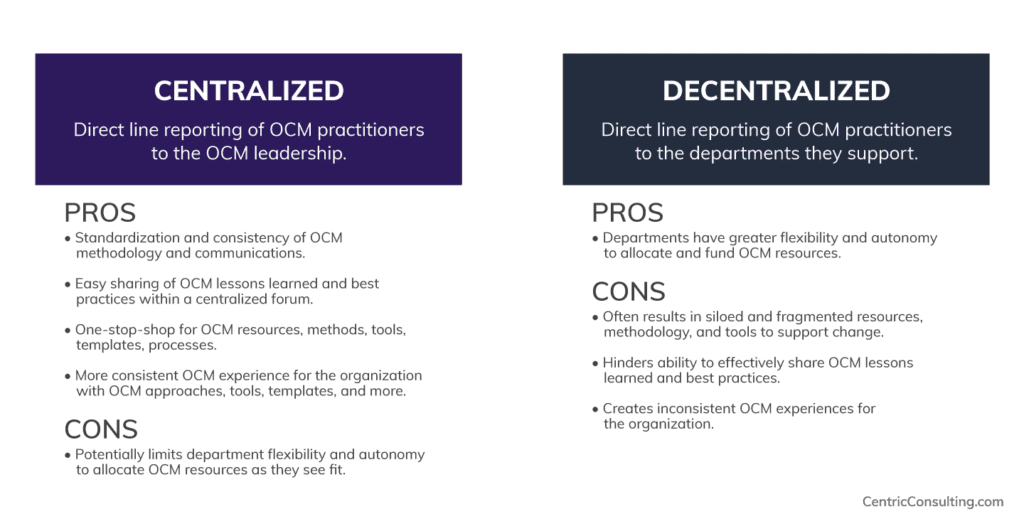Increasingly, as companies go through major transitions or changes, organizational change management is being recognized as a critical component to obtaining their desired business results and achieving long-term competitive advantage.
A January 2020 Harvard Business Review article stated, “Virtually every organization will, at some point, undergo a transition or change to remain viable and scalable. Change, although challenging, can be a major opportunity for growth and career advancement, so long as you know how to approach it.”
Since the COVID pandemic, our experts have noted a significant increase in clients requesting Organizational Change Management (OCM) support as they undertake major change initiatives – such as process redesign, technology implementations, data analytics, culture transformations, and more.
In addition, we’re seeing more clients ask for help building OCM capability – realizing that OCM expertise is different from, but also complementary to, Human Resources (HR), Corporate Communications, and Corporate Training. As companies go through major transitions or changes, they increasingly recognize OCM as a critical component to obtaining desired business results and achieving long-term competitive advantage.
The post-COVID business environment opened the door for companies to build internal OCM capability. Yet, there is still little information available about when to establish internal OCM capabilities, which level of maturity to target, how to integrate it, and where it should operationally reside. It is also vital that everyone involved (especially senior leadership) has the same baseline understanding of what OCM is and why it is important. In this blog, we will discuss each of these elements that our experts see as the building blocks for the foundation of a successful internal OCM capability.
What Is OCM?
Forbes Advisor defines OCM as “a structured process for planning and implementing new ways of operating within an organization.” However, OCM is much more than solely providing a roadmap or training to impacted stakeholders. It entails anchoring the desired change into the new way of working by:
- Building a compelling need for change – winning the hearts.
- Creating opportunities for dialogue and collaboration – winning the minds.
- Supporting those impacted throughout their change journey – anchoring the change.
Moreover, OCM is about changing the way people work to make an organization more successful and competitive in the marketplace. This discipline seeks to actively understand and ensure the readiness of people impacted by change. Simply put, OCM addresses the people side of change.
Why OCM is Important
OCM drives faster adoption, greater utilization, and increased proficiency which in turn helps foster positive change and successful project outcomes. According to Prosci’s Best Practices in Change Management 2020 Benchmark Report, “Successful change implementations produce better project outcomes. Projects with excellent change management produce as much as 6x better outcomes compared to those that have poor change management.”
With the rate of change dramatically rising, stakeholder engagement is crucial to achieving desired business outcomes. Increasing the speed at which stakeholders move from current to future state (faster adoption), increasing their levels of usage (greater utilization), and improving their skillsets (increased proficiency) are necessary success measurements OCM offers. Organizations that focus on building a change capability will, ultimately, create higher satisfaction or “stakeholder joy” and deliver sustainable business results.
When to Establish Internal OCM Capabilities
Establishing internal OCM capabilities requires the active support and engagement of senior executives (C-suite level) from concept and strategy to development and execution. To successfully build long-lasting internal OCM capabilities, senior leadership downward must see the discipline as a valuable addition to the team.
The creation and maintenance of “OCM Credibility” within the organization is part of the foundation, making it a critical success factor for internal OCM capabilities. Through executive alignment and continuous engagement, it is more likely that senior executive(s) will:
- Allocate appropriate resources — such as budget, talent, and time — to OCM.
- Distribute key messages detailing the importance of OCM top-down throughout the organization.
- Select and invest in strategic, transformational initiatives for OCM to support.
- Cultivate OCM into the organization for long-term success.
Ultimately, identifying at least one high-ranking executive to formally sponsor your OCM Capability build is an important initial step. This individual will provide executive oversight, help clear major roadblocks and keep other influential executives engaged.
Getting Leadership Buy-In
“In its most basic sense, leadership is about mobilizing a group of people to jump into a better future,” said John P. Kotter.
What if you don’t have the support of senior leadership? Understanding and desire can also create a foundation for obtaining support and engagement for building internal OCM capability. As discussed earlier in this blog, understanding involves positioning OCM in your organization by defining what it is and why it is important, as well as the correlation between the costs and consequences of not having the capability.
So, how do you develop desire? Executives base interest and desire on the familiar question, “What’s in it for me?” About “me” refers to the company. It is essential to achieve positive project outcomes while building OCM capability. Then, illustrating those outcomes will help create the desire. Two examples of how to demonstrate and promote positive outcomes from OCM include:
- Identify an enterprise-wide project where you can incorporate OCM and then track and showcase the positive outcomes.
- Provide details for an existing project about how you incorporated OCM and the positive outcomes.
Which Level of OCM Maturity Should You Target?
We have developed a 5-level OCM Maturity Model to help companies assess current and target maturity levels. This model can be leveraged to assess a company’s current OCM capability level and determine their optimal target level based upon factors such as culture, size, OCM need, and so on, as well as illustrate the steps required to level-up in your OCM change journey.
Your instinct may be to skip to the level you aspire to be, but you must methodically move from one level to the next. This takes time – sometimes, years. At the start, change is reactive and ad-hoc. Moving up from the first levels requires building minimum OCM standards and implementing basic OCM methodology. Typically, clients buy, build, or create a hybrid of both for their methodology.
As you reach the middle of the OCM Maturity Model, you continue to build depth and breadth into your OCM methodology. If a strategic initiative has not been selected yet, then it is selected and OCM support is provided. In addition, at this mid-level, OCM requires developing an intake process as a key part of your resource allocation management. If it makes sense for OCM to engage, then you can determine the type of activities needed and the size of the request, such as duration and resources.
For many companies, reaching level three is considered “good enough.” Companies that move to levels four and five of the OCM Maturity Model have established executive leadership buy-in, tangible success stories, and continued OCM strategies that align to business outcomes. These upper levels focus on complex OCM strategizing, resource optimization, competency modeling, behavioral incentives, stakeholder advocacy, and more. Most importantly, it leads to developing a structured OCM center of expertise and strategic partnership with senior leadership.
How to Integrate Your OCM Capability
As you move through the levels of the OCM Maturity Model, centralizing your OCM competencies and resources will provide a direct-line reporting structure and solidify a focused, methodical, and integrated approach.
How you integrate OCM capability into your company helps determine the optimal way to structure and use your change resources. Many organizations struggle with deciding between a centralized or decentralized OCM approach. Below are some considerations to help you decide:
Generally, we recommend centralizing your OCM competencies and resources as you move through the initial stages of your OCM capability. This provides a direct line OCM reporting structure and solidifies a focused, methodical and integrated approach.
According to Prosci’s 2019 Benchmarking Report, “Data and experience show that a functional group focused on change management provides value on the enterprise journey to build change management maturity. The group also delivers value and creates credibility for the change management capability journey by demonstrating the commitment senior leaders have made in establishing this center.”
As your maturity grows and your OCM capabilities become well established, there can be benefits to a matrixed structure in which the business owns smaller, less complex projects. To successfully use this approach, matrixed business resources must have knowledge of structured and standardized OCM practices and methodology while also receiving guidance from centralized experienced OCM resources.
Where to Successfully Build Your OCM Capability
Where the OCM capability should organizationally reside requires a determination of the company’s change competency, maturity, and strategic alignment. Current practices often place OCM resources in Information Technology (IT) and Human Resources (HR) departments as well as Program Management Offices (PMO). Though these locations work, in many instances, they can limit the strategic value that OCM brings.
Recently, as strategy and agility become increasingly important, more companies are creating Business Transformation, Operational Efficiency, or Business Strategy departments that report directly to C-Suite executives. This new breed of department is focused on leading-edge, revolutionary, large-scale transformations. Incorporating OCM within this new department helps inspire companies to effectively:
- Focus on strategic business goals and achieving desired outcomes.
- Provide direct integration into planning and resourcing of corporate initiatives.
- Enable an enterprise perspective and support for a diverse portfolio of projects such as process, culture, IT, mergers and acquisitions.
- Attain access to executives as well as important changes and direction.
- Become part of the mindset and culture of the enterprise.
A 2022 Prosci webinar on How to Stand Up a CMO notes, “We do not have a strategic orientation for managing the many changes we are deploying. We need this to ensure our organization has the ability to respond to the growth/changes.”
Conclusion
As writer and biochemist Isaac Asimov famously said, “There is an art to science, and science in art; the two are not enemies, but different aspects of the whole.” Building an internal OCM capability requires a balance of both science and art.
The science focuses on designing and rolling out an effective OCM team structure, methodology and performance measures, while the art is gaining the support and engagement of senior leadership as well as the entire organization to build, nurture, and sustain a lasting internal OCM Capability. All of this results in companies being better able to meet their desired business results and achieve long-term competitive advantage.




